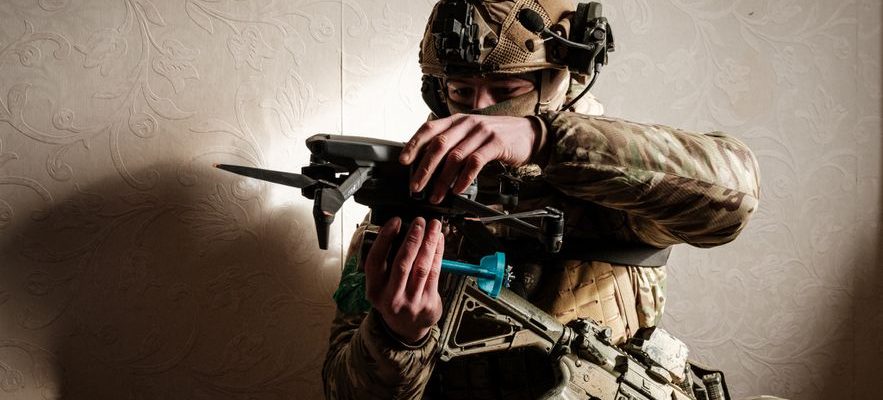In appearance, a simple khaki container, hidden under branches. In reality, a war chest, quickly handed over to the United States, eager to analyze its secrets. In March 2022, Ukrainian forces seized a key piece of the Russian arsenal, the command post of a Krasukha-4. This powerful jamming system is capable of blocking satellite signals on the equivalent of half of French metropolitan territory and of disrupting American AWACS-type radar planes. A real poison: “krasukha” designates, in Russian, belladonna, a plant with toxic black berries.
It is not only on land, at sea, in the air or through cyber networks that Russians and Ukrainians oppose each other. A field invisible to the naked eye is the subject of an incessant and crucial confrontation, that of the waves, the theater of what the military calls “electronic warfare”. The belligerents engage in a veritable game of chess via systems using infrared signals, radar, radio or other transmissions to detect their sources – and transmit their coordinates to the artillery -, pick up the content of communications or disturb – essentially by emitting an overload signal.
“The war in Ukraine makes us rediscover the importance of the electromagnetic field, which is highly contested there,” recalled a French officer during a seminar organized in early June by the association Guerrélec. This shadow struggle could thus have a significant impact on the current counter-offensive. “The ability of the Ukrainian army to find and destroy Russian electronic warfare systems (…) will be a key factor in offensive success”, underlines a recent report from the Center for Strategic and International Studies think tank. This is one more obstacle for the Ukrainians to overcome, in addition to minefields, trenches and anti-tank ditches, if they want to reconquer their territories.
Ukrainian drones under Russian threat
The Russians have a panoply of land tools without equivalent on the planet, the result of know-how developed during the Soviet era, to undermine one of the strengths of the American army, its capabilities communication and listening. On Bakhmut they would thus have used for the first time a still secret system, Tobol, to disrupt Ukrainian forces’ use of Elon Musk’s Starlink satellite internet service. Their R-330ZH Zhitel, with an estimated range of 30 kilometers, would also have managed to blind the guidance of American missiles like the Himars or the JDAMsused by the Ukrainians for deep strikes.
“The Russians have deployed all the electronic warfare weapons at their disposal, which allow them to act on the entire spectrum in eavesdropping and jamming,” confirms a military source. They “now employ a major electronic warfare system every 10 kilometres, usually located about 7 kilometers from the line”, believes the London think tank RUSI. Among them, the Shipovnik-Aero, with a range of 15 kilometers. This “drone reaper” has a “low signature and can further obscure it by mimicking other transmitters and communication stations”. There are also smaller pieces of equipment to equip “units at all levels”.
A Ukrainian soldier from the National Border Guard Service presents a drone in Bakhmout, February 9, 2023.
© / afp.com/YASUYOSHI CHIBA
This network would cause the Ukrainians to lose 10,000 drones per month, says RUSI. But it can be a double-edged sword. “In the absence of discriminating systems, the Russians often do total jamming, which sometimes affects them as much as the Ukrainians”, notes Thibault Fouillet, researcher at the Foundation for Strategic Research. These also have state-of-the-art equipment, developed following the annexation of Crimea. Their Bukovel-AD, in service since 2016, can detect a drone 100 kilometers away and cut it off from its pilot when it is within 20 kilometers. kyiv also receives Western systems, like the Parade of the French industrialist Thalès, or some Israeli equipment. The United States has also recorded several deliveries of electronic warfare weapons, while remaining discreet about the technologies transferred.
This electronic struggle takes the form of a game of cat and mouse. To counter certain jamming aimed at their small reconnaissance quadricopters, the Ukrainians sometimes resort to pre-programmed flight plans. “They explain that their parades take an average of two weeks before the Russians find a solution, which leads to new adjustments, and so on,” said a well-informed source.
Back to old systems
Electronic warfare is not limited to jamming. It also aims to pick up enemy communications and detect potential targets via radars and listening stations. The possibilities of detection are so numerous that the Russian commanders now prefer to connect to the terrestrial telephone network of the occupied zones to avoid taking shells or missiles on the head – several generals were thus eliminated in the first months of the invasion. Ukrainians also resort to corded field phones reminiscent of the world wars of the 20th century. They allow them to avoid the sensors of the Russian Leer-3, able to intercept 3G, 4G communications and SMS.
In this race, the Ukrainians have long enjoyed a head start. Thanks to applications developed since 2014, they have reduced the loop of detection, targeting and then striking by artillery units to less than a minute. But over the months, the Russians have also reduced their own loop, forcing Ukrainian drone pilots and gunners to ever more mobility. “It is much easier for the Russians to deploy their systems than at the start of the invasion, when the front line was too fluid for them,” said Yves Pagot, from the Center Interdisciplinary d’Etudes pour la Défense et la Sécurité. of the Polytechnic Institute.
This does not help the affairs of the Ukrainians. “Russian electronic warfare capabilities were key in complicating Ukrainian attacks in the direction of Zaporizhia,” notes the Institute on the Study of War, based in Washington. He adds that it is “unclear” whether these alleged successes are “the result of superior capabilities or better employment of these systems”. “There are always parades,” recalls a high-ranking officer. It remains for the Ukrainians to find and apply them, in order to guarantee the success of their counter-offensive.
